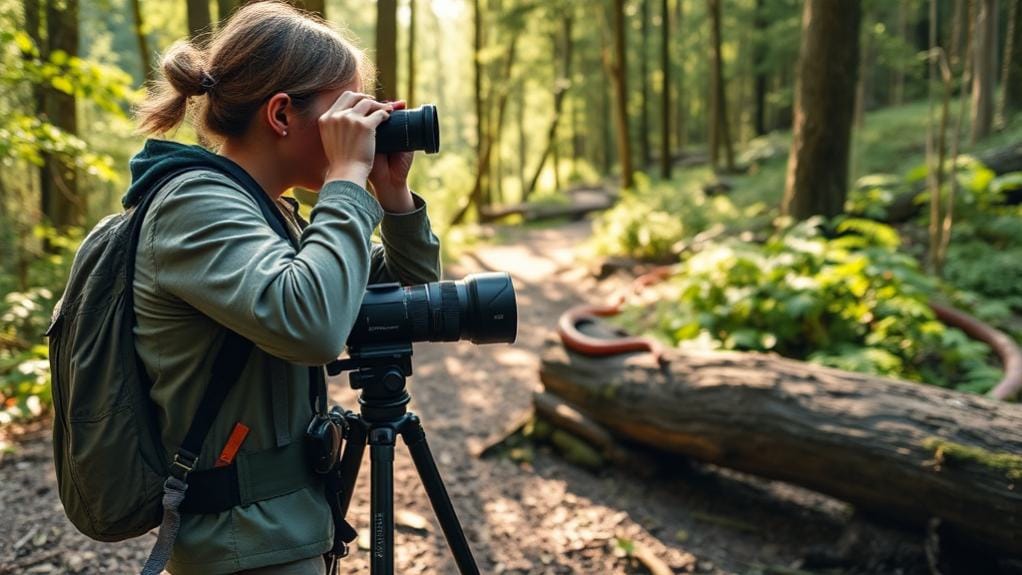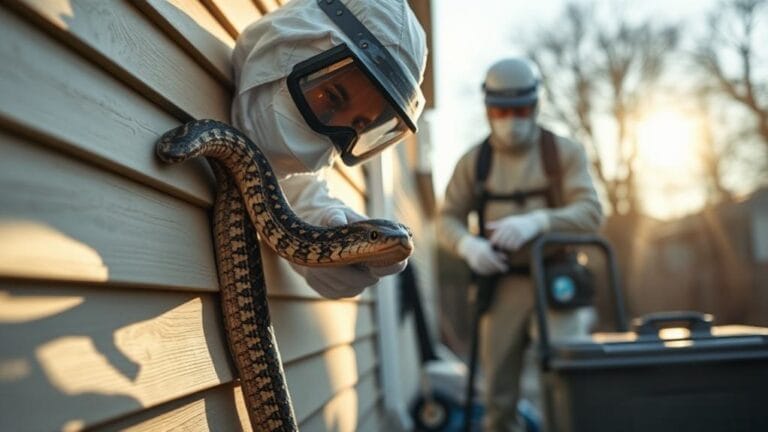I'll help you spot the difference between venomous and non-venomous snakes, but don't get cocky – this isn't foolproof. Most venomous snakes have triangular heads and vertical pupils (like a cat's eye), while non-venomous ones usually sport rounded heads and circular pupils. The "red touch yellow, kill a fellow" rule works for coral snakes, but there's way more to it. Location matters big time – knowing which species live in your area is essential. Never try to handle or get close to any snake, period. Your best move? Back away slowly and let it be. But if you're really curious about becoming a snake-spotting pro…
Key Physical Snake Characteristics
Table of Contents
Snake identification requires understanding key physical traits that distinguish venomous from non-venomous species.
I'll help you spot the differences – because let's face it, nobody wants to play a guessing game with a snake!
Heavy-duty snake traps can help safely capture and relocate these reptiles once properly identified.
Look at these dead giveaways:
- Head shape: Venomous snakes rock that distinctive triangular head. Non-venomous ones? They're keeping it round and simple (though some try to fake it – nice try, buddy).
- Pupils: Check those eyes! Venomous snakes have cat-like slits. Non-venomous ones sport round pupils like they're posing for a yearbook photo.
Pro Tip: Never rely on just one feature. You'll want to check multiple characteristics because Mother Nature loves throwing curveballs.
Trust me – memorizing these traits could save you from an extremely bad day.
But when in doubt? Just back away slowly.
Head Shape and Structure

Precision matters when examining a snake's head shape and structure – it's often your first clue in determining whether you're dealing with a venomous or non-venomous species.
I'll tell you straight up: venomous snakes typically rock that distinctive triangular head shape, while their non-venomous cousins usually keep it more rounded and subtle.
While natural snake deterrents like cedar oil and cinnamon can help keep them away, learning to identify them is essential for safety.
Pro tip: Don't get fooled by those sneaky non-venomous copycats that flatten their heads to look scary!
Here's what you need to watch for:
- Venomous snakes pack those broad, triangle-shaped heads (think angry arrowhead)
- Most non-venomous snakes sport a rounded, streamlined look
- Pit vipers show off special heat-sensing pits between eyes and nostrils
- Watch out for coral snakes – they break the rules with rounded heads but pack serious venom
Snake Eye Patterns

Safety in snake identification often comes down to the eyes. I'm going to share an essential tip: venomous snakes typically have slit-like pupils, while non-venomous ones have round pupils. But don't get cocky – there's always an exception (looking at you, coral snakes).
| Feature | Venomous | Non-Venomous |
|---|---|---|
| Pupil Shape | Usually Slit | Usually Round |
| Distance Check | Stay Far Back | Stay Far Back |
| Exceptions | Coral Snake | Some Tree Snakes |
| Head Shape | Often Triangular | Usually Rounded |
| Reliability | Medium | Medium |
*Pro Tip: You can't identify a snake by eyes alone, and I'd rather you didn't try getting close enough to check anyway!*
Common Venomous Snake Species

Let me introduce you to America's four most dangerous serpents: rattlesnakes, copperheads, cottonmouths, and coral snakes.
I know you're dying to meet them (hopefully not literally). Each year, over 7,000 people learn the hard way not to mess with these guys. If you encounter these snakes near your home, professional pest control can safely remove and relocate them.
- Rattlesnakes are the show-offs of the bunch, with their fancy tail-shaking warning system.
- Cottonmouths, aka water moccasins, are the grumpy swimmers who'll stand their ground when threatened.
- Coral snakes rock those fancy red, yellow, and black bands (not to be confused with their copycat cousins).
- Copperheads sport those distinctive hourglass patterns and love hanging out in eastern states.
*Pro tip: If you're trying to figure out which one you just saw, you're already too close. Back away slowly and leave the snake ID to us experts.*
Snake Behavior in Different Habitats

Nature has equipped each snake species with behaviors perfectly suited to their preferred stomping grounds. For maximum safety, consider partnering with snake control breeds like terriers that are naturally skilled at detecting and deterring these reptiles.
I'm here to help you understand snake behavior based on geographical location – it could save your life when trying to ID venomous versus non-venomous species.
Let me break it down for you:
- Rattlesnakes love arid areas and (surprise!) they'll actually warn you with that famous rattle. How thoughtful of them.
- Cottonmouths hang out near water and won't hesitate to stand their ground. Yeah, they're not exactly the welcoming committee.
- Copperheads? They're the sneaky ones in forest areas, relying on camouflage instead of drama.
*Pro tip: Learning your local snake species' typical behaviors isn't just fun trivia – it's your best bet for staying safe in their territory.*
Color and Pattern Recognition

While snake behavior offers key clues to identification, a snake's visual appearance can tell an even more detailed story. Understanding a snake's venom composition and production is vital for proper identification, as specialized venom glands can sometimes affect head shape.
Let me break down the tricky world of color variations so you don't end up learning the hard way!
Let's get one thing straight – those brightly colored snakes aren't always trying to kill you. Pattern recognition is your best friend here, and I'll tell you why:
- Coral snakes follow the "red touch yellow, kill a fellow" rule – but their copycat cousins, the scarlet king snakes, won't pack that venomous punch
- Think you've spotted a deadly copperhead? Those hourglass patterns might just belong to a harmless rat snake
- Some venomous snakes rock those warning colors, but plenty of non-venomous ones are just really good at bluffing
- Nature loves camouflage, so don't assume dull colors mean safe snakes
Geographic Distribution of Snakes

Snake populations follow distinct geographical patterns that can make identification much easier.
Let me break down where you'll find North America's most notorious venomous snakes – because knowing their geographic distribution could save your life.
Pro tip: Location alone isn't enough for identification, but it's a huge clue!
Here's what you need to know:
- Rattlesnakes: These guys are everywhere (seriously, they love spreading out). You'll find them across both American continents.
- Copperheads: Stick to the eastern U.S. – they're basically forest-loving homebodies.
- Cottonmouths: Total water babies in the southeast. If you're near water in Florida, assume they're watching you.
- Coral snakes: Southern underground dwellers. They're like the introverts of the snake world.
Remember: Antarctica's the only continent where you won't find snakes. Lucky penguins.
Safe Snake Observation Methods

Observing snakes safely requires a thoughtful balance of curiosity and caution.
I'll help you identify snakes and observe their behavior without becoming their next meal. Trust me – keeping a safe distance of 10 feet isn't being chicken, it's being smart.
- Grab those binoculars or that fancy zoom lens camera you never use – now's their time to shine!
- Study local snake species before heading out (because surprise encounters aren't fun).
- Watch how they react to your presence – non-venomous ones usually bolt while venomous ones play statue.
- For Pete's sake, don't try to handle them – you're not Steve Irwin.
Pro tip: The best snake observation is a distant snake observation.
If you can't tell what kind of snake it's from a safe distance, just assume it's venomous and back away slowly. No snake photo is worth a hospital visit!
Snake Prevention and Control

A secure yard is your first line of defense against unwanted serpentine visitors.
Let's face it – nobody wants to identify venomous snakes up close and personal in their own backyard.
I'll show you how to make your property less appealing to these potential predators.
Start with these no-nonsense snake prevention basics:
- Clear out that jungle you call a yard – snakes love tall grass and debris
- Install snake-proof fencing (yes, it's a thing and it works)
- Use snake repellents strategically around your property's perimeter
Pro tip: Get your neighbors on board with snake safety practices. A snake-smart community is a safer community.
If you're already dealing with unwanted scales, don't play hero.
Call professional wildlife removal services. They'll handle the situation safely and help snake-proof your property.
Frequently Asked Questions
How to Tell if a Snake Is Venomous or Not?
I'll tell you to look for triangular heads, slit pupils, and heat-sensing pits between eyes and nostrils. Don't rely on colors alone, as some non-venomous snakes mimic venomous patterns.
How Do You Distinguish Between Poisonous and Non Poisonous Snakes?
Let me put your mind at ease. I look for triangular heads, slit pupils, and heat-sensing pits between eyes and nostrils. I'll also watch for defensive behavior, though colors aren't a reliable indicator.
How to Tell the Difference Between a Venomous Snake and a Non Venomous Snake Bite?
I'll tell you that venomous bites show wide-set fang marks, severe swelling, and systemic symptoms like nausea. Non-venomous bites have closer puncture marks with mild irritation but no serious symptoms.
How Do You Identify Snake Venom?
Like a detective at a crime scene, I'll tell you that snake venom shows clear signs: severe swelling, intense burning pain, bruising, and blistering around the bite area. I'd look for these symptoms first.
Last Word
Learning to identify snakes is like building your survival toolkit – it's a skill that could save your life. I've shared these identification methods because I want you to be confident, not paranoid, in snake territory. You've got the knowledge now, so use it wisely. Remember: most snakes would rather flee than fight. Stay alert, keep your distance, and you'll be fine. Just don't try to be a snake charmer, okay?








